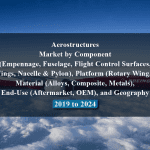OVERVIEW
The High Altitude Pseudo Satellite Market is currently valued at USD 85 million in 2024 and will be growing at a CAGR of 17.2% over the forecast period to reach an estimated USD 189 million in revenue in 2029. The High Altitude Pseudo Satellite (HAPS) market is a rapidly evolving sector at the intersection of aerospace and telecommunications, characterized by the deployment of unmanned aerial vehicles (UAVs) at stratospheric altitudes to perform various tasks traditionally undertaken by satellites. HAPS offer distinct advantages such as prolonged endurance, flexibility in deployment, and lower costs compared to conventional satellites, making them ideal for applications like communication relays, surveillance, environmental monitoring, and disaster management. With advancements in solar-powered propulsion, lightweight materials, and communication technologies, the HAPS market is witnessing significant growth, attracting investments from both governmental and private entities. As demand for high-altitude services continues to rise, driven by expanding connectivity needs and environmental concerns, the HAPS market is poised for further expansion and innovation in the coming years.
Firstly, the increasing demand for connectivity in remote areas and the expansion of telecommunications networks drive the adoption of HAPS for communication relays, offering a cost-effective solution to bridge the digital divide. Secondly, the growing need for persistent surveillance and reconnaissance capabilities, particularly for border security, disaster management, and environmental monitoring, fuels the deployment of HAPS platforms equipped with advanced imaging and sensor technologies. Additionally, advancements in lightweight materials, solar-powered propulsion systems, and miniaturized electronics are enhancing the endurance, payload capacity, and operational efficiency of HAPS, further stimulating market growth. Moreover, regulatory initiatives supporting the integration of HAPS into existing airspace management frameworks and the emergence of public-private partnerships are facilitating the commercialization and scalability of HAPS solutions, driving innovation and investment in this rapidly evolving sector.
Table of Content
Market Dynamics
Drivers:
Firstly, the increasing demand for connectivity in remote areas and the expansion of telecommunications networks drive the adoption of HAPS for communication relays, offering a cost-effective solution to bridge the digital divide. Secondly, the growing need for persistent surveillance and reconnaissance capabilities, particularly for border security, disaster management, and environmental monitoring, fuels the deployment of HAPS platforms equipped with advanced imaging and sensor technologies. Additionally, advancements in lightweight materials, solar-powered propulsion systems, and miniaturized electronics are enhancing the endurance, payload capacity, and operational efficiency of HAPS, further stimulating market growth. Moreover, regulatory initiatives supporting the integration of HAPS into existing airspace management frameworks and the emergence of public-private partnerships are facilitating the commercialization and scalability of HAPS solutions, driving innovation and investment in this rapidly evolving sector.
Key Offerings:
Key offerings in the High Altitude Pseudo Satellite (HAPS) market encompass a diverse range of capabilities tailored to meet the evolving needs of various industries. These offerings include advanced communication systems enabling long-range data transmission and internet connectivity, suitable for bridging connectivity gaps in remote or underserved areas. Additionally, HAPS platforms equipped with high-resolution imaging sensors and surveillance technologies provide persistent aerial monitoring for applications such as border security, disaster response, and environmental surveillance. Furthermore, the integration of atmospheric monitoring sensors and weather forecasting capabilities enhances HAPS’ utility in meteorological research and climate monitoring efforts. Moreover, customizable payload options allow for tailored solutions to meet specific customer requirements, ensuring versatility and adaptability across a wide array of missions and applications. As the market continues to evolve, innovation in propulsion systems, materials science, and data processing technologies further enriches the offerings of HAPS providers, enabling them to address emerging challenges and opportunities in aerospace and telecommunications.
Restraints :
The High Altitude Pseudo Satellite (HAPS) business has a lot of promise, but there are a lot of big obstacles in the way of it expanding as it should. First of all, the deployment of HAPS necessitates navigating complicated aviation laws and obtaining licences from numerous regulatory agencies. These problems and issues with airspace integration are barriers to the technology’s general adoption. Concerns about spectrum allocation, privacy, and data security all create doubts and could make it harder for HAPS solutions to be adopted, especially in delicate applications like communications and surveillance. The development of strong and lightweight materials, effective propulsion systems, and dependable communication links are examples of current technological constraints that could impede the rate of innovation and adoption in the HAPS market. In addition, economic considerations like high upfront costs, a hazy ROI, and competition from competing technologies like terrestrial infrastructure and low-Earth orbit (LEO) satellites could limit market expansion and erode investor trust in the near run. In order to overcome these obstacles, industry players, legislators, and regulatory agencies must work together to improve technological capabilities, address legal frameworks, and create an environment that supports the long-term development of HAPS solutions.
Regional Information:
• In North America, particularly in the United States, the High Altitude Pseudo Satellite (HAPS) market is driven by a robust ecosystem of aerospace innovation, strong governmental support for research and development, and a thriving telecommunications industry. Companies based in the region benefit from access to advanced technological infrastructure, world-class research institutions, and a skilled workforce, fostering innovation and accelerating the development of HAPS platforms and technologies. Additionally, the Federal Aviation Administration’s (FAA) progressive approach to regulating unmanned aerial systems (UAS) and emerging technologies creates an environment conducive to experimentation and commercialization in the HAPS market. Furthermore, strategic partnerships between industry players, government agencies, and academic institutions further bolster the region’s position as a global leader in HAPS development and deployment.
• In Europe, the High Altitude Pseudo Satellite (HAPS) market benefits from a strong aerospace industry, advanced technological infrastructure, and supportive regulatory frameworks. Countries such as the United Kingdom, France, and Germany host prominent players like Airbus and Thales Alenia Space, which are actively involved in HAPS development. The European Union’s initiatives promoting innovation and research, coupled with collaborative projects such as the European High Altitude Platform Station (HAPS) program, stimulate market growth and foster cross-border cooperation. Moreover, Europe’s emphasis on sustainability and environmental stewardship aligns well with the potential applications of HAPS in areas like climate monitoring and disaster response.
• The Asia-Pacific region, countries like Japan, China, and India are emerging as key players in the HAPS market. Japan’s strong aerospace industry, coupled with its focus on technology-driven innovation, positions the country as a frontrunner in HAPS development. China’s ambitious space program and growing investment in aerospace technologies drive market expansion, with companies like Huawei and DJI exploring HAPS applications. India’s burgeoning space industry and expertise in remote sensing contribute to the region’s growing prominence in the HAPS market. Additionally, the Asia-Pacific’s vast geographic expanse and diverse terrain create significant demand for HAPS solutions to address connectivity challenges and support disaster management efforts. Collaborative initiatives like the Asia-Pacific HAPS Alliance further promote regional cooperation and knowledge exchange, driving innovation and market growth across the region.
Recent Developments:
• In July 2023, PHASA-35 successfully completed a stratospheric flight trial in June 2023, exceeding an altitude of 66,000ft, before landing safely in New Mexico, US.
• In March 2023, Thales group signed a contract with the European Commission for the EuroHAPS demonstration project worth USD 45.4 million. The contract includes development of three different stratospheric platforms to test a range of capabilities and missions including intelligence, surveillance, and reconnaissance (ISR) as well as communications and electronic intelligence. Light detection and ranging (LIDAR) observation, to detect and classify targets at sea or on land including in vegetation cover, and a meshed broadband communications network will also be trialled.
Key Market Players:
Airbus, AeroVironment, Boeing, Thales Alenia Space, Alphabet Inc. (Google), Lockheed Martin, Aerovironment, BAE Systems, Northrop Grumman, and Bye Aerospace.
Frequently Asked Questions
1) What is the projected market value of the High Altitude Pseudo Satellite Market?
– The High Altitude Pseudo Satellite Market is expected to reach an estimated value of USD 189 million in revenue by 2029.
2) What is the estimated CAGR of the High Altitude Pseudo Satellite Market over the 2024 to 2029 forecast period?
– The CAGR is estimated to be 17.2% for the High Altitude Pseudo Satellite Market over the 2024 to 2029.
3) Who are the key players in the High Altitude Pseudo Satellite Market?
– Airbus, AeroVironment, Boeing, Thales Alenia Space, Alphabet Inc. (Google), Lockheed Martin, Aerovironment, BAE Systems, Northrop Grumman, and Bye Aerospace.
4) What are the drivers for the High Altitude Pseudo Satellite Market?
– The adoption of High-Attenuated Positioning Systems (HAPS) is driven by increasing demand for connectivity in remote areas, persistent surveillance, and environmental monitoring. Advancements in lightweight materials, solar-powered propulsion systems, and miniaturized electronics enhance HAPS’ endurance, payload capacity, and operational efficiency. Regulatory initiatives and public-private partnerships drive innovation.
5) What are the restraints and challenges in the High Altitude Pseudo Satellite Market?
– The High Altitude Pseudo Satellite (HAPS) market faces challenges such as regulatory hurdles, privacy concerns, and technological limitations. It requires navigating complex airspace regulations, securing permissions, and addressing privacy, data security, and spectrum allocation issues. Economic factors like high initial investment costs and competition from alternative technologies may also hinder market growth. Overcoming these restraints requires collaboration between industry stakeholders, policymakers, and regulatory bodies.
6) What are the key applications and offerings of the High Altitude Pseudo Satellite Market?
– The High Altitude Pseudo Satellite (HAPS) market offers advanced communication systems, high-resolution imaging sensors, and surveillance technologies for various industries. These platforms provide persistent aerial monitoring, weather forecasting, and customizable payload options. As the market evolves, HAPS providers can address emerging challenges and opportunities in aerospace and telecommunications, leveraging advancements in propulsion systems, materials science, and data processing technologies.
7) Which region is expected to drive the market for the forecast period?
– North America is expected to have the highest market growth from 2024 to 2029
Why Choose Us?
Insights into Market Trends: Global Market Studies reports provide valuable insights into market trends, including market size, segmentation, growth drivers, and market dynamics. This information helps clients make strategic decisions, such as product development, market positioning, and marketing strategies.
Competitor Analysis: Our reports provide detailed information about competitors, including their market share, product offerings, pricing, and competitive strategies. This data can be used to inform competitive strategies and to identify opportunities for growth and expansion.
Industry Forecasts: Our reports provide industry forecasts, which will inform your business strategies, such as investment decisions, production planning, and workforce planning. These forecasts can help you to prepare for future trends and to take advantage of growth opportunities.
Access to Industry Experts: Our solutions include contributions from industry experts, including analysts, consultants, and subject matter experts. This access to expert insights can be valuable for you to understand the market.
Time and Cost Savings: Our team at Global Market Studies can save you time and reduce the cost of conducting market research by providing comprehensive and up-to-date information in a single report, avoiding the need for additional market research efforts.












